Let me ask you something: Are you creating content but wondering why it's not turning into sales?
I've been there. Back when I was drowning in $180,000 of law school debt and trying to figure out how to make money online, I made this exact mistake. I'd pump out blog posts, social media content, and videos. But nothing connected. My content felt like shouting into the void.
Here's what I learned after generating over $30 million online: Content without a strategic funnel is just expensive entertainment.
Most online business owners treat content marketing like throwing spaghetti at the wall. They create random posts, hope someone notices, and wonder why their conversion rates suck. But the successful ones? They understand that every piece of content serves a specific purpose in moving prospects through a predictable journey.
In this guide, I'll show you how to build a content marketing funnel that actually converts—the same principles I've used with my high-ticket e-commerce students who've scaled from zero to multiple six figures.
Why Online Businesses Need a Content Marketing Funnel
Picture this scenario: Someone discovers your brand through a TikTok video, visits your website, reads one blog post, and... disappears forever. Sound familiar?
This happens because you don't have a systematic way to guide prospects from initial awareness to purchase decision. You're relying on the hope that they’ll remember you, come back, and eventually buy.
A content marketing funnel solves this by creating a structured pathway that nurtures prospects at each stage of their buying journey. Instead of random one-off interactions, you're building relationships and trust systematically.
Difference Between Marketing Funnels, Sales Funnels, and Content Marketing Funnels
Let's clear up the confusion because most people use these terms interchangeably (and wonder why their results are inconsistent).
A marketing funnel is the broader framework that maps out how prospects move from awareness to purchase. Think of it as the highway system: it shows the overall route but doesn't specify what vehicle you're driving.
A sales funnel, on the other hand, focuses specifically on the conversion process, usually starting from when someone becomes a lead. It's more tactical: lead magnet → nurture sequence → sales page → checkout. This is your direct-response engine.
Lastly:
A content marketing funnel uses valuable content as the primary vehicle to move prospects through each stage. Instead of aggressive sales pitches, you're educating, entertaining, and building authority. Content becomes both the traffic source and the nurturing mechanism.
Here's why this distinction matters: Most online businesses try to force sales funnels when they need content marketing funnels first. You can't just blast someone with a sales page when they don't know, like, or trust you yet.
Content marketing funnels work well for:
- High-ticket services and products (like my students selling $5,000+ items)
- Complex solutions that require education
- Competitive markets where trust is crucial
- Businesses selling transformation rather than commodities
The magic happens when you combine all three: content attracts and nurtures, marketing qualifies and segments, and sales converts and delivers.
While these distinctions might seem subtle, understanding the nuanced differences between each funnel type is critical for allocating resources effectively and choosing the right strategy for your business model. For a comprehensive breakdown of how these frameworks differ in structure, metrics, and optimal use cases, explore our detailed comparison of sales funnels vs marketing funnels, which clarifies when to deploy each approach for maximum conversion impact.
What Is a Content Marketing Funnel?
A content marketing funnel is a strategic system that uses valuable content to attract strangers, convert them into leads, nurture those leads into customers, and turn customers into advocates.
But here's where most people get it wrong: They think it's just about creating more content.
Wrong.
It's about creating the right content for the right person at the right stage of their buying journey. Every piece of content has a job: whether that's generating awareness, building trust, handling objections, or driving action.
Think of your content marketing funnel like a high-end restaurant experience. You don't walk in and immediately get presented with the bill. First, there's the ambiance that draws you in (awareness content), the menu that educates you on options (consideration content), the server's recommendations that build confidence (decision content), and the exceptional experience that makes you a regular (retention content).
The most successful online businesses I've worked with understand this sequence. They don't just create content—they architect experiences that guide prospects naturally toward purchase decisions.
Stages of the Content Marketing Funnel
1. Top of the Funnel (TOFU) – Awareness
The goal of this funnel is to turn strangers into audience members who know you exist and see you as credible.
At the top of your funnel, prospects don't even know they have a problem. Or they know they have a problem but don't know solutions exist. Your job isn't to sell anything. It's to be discovered, provide value, and earn attention.
I call this "being useful before being salesy." When I started creating content about high-ticket e-commerce, I wasn't pitching courses. I was sharing case studies, breaking down successful stores, and explaining concepts people didn't understand. This built my reputation as someone worth listening to.
You can confirm this on my YouTube channel. It contains over 70 (no-BS) videos on high-ticket dropshipping:
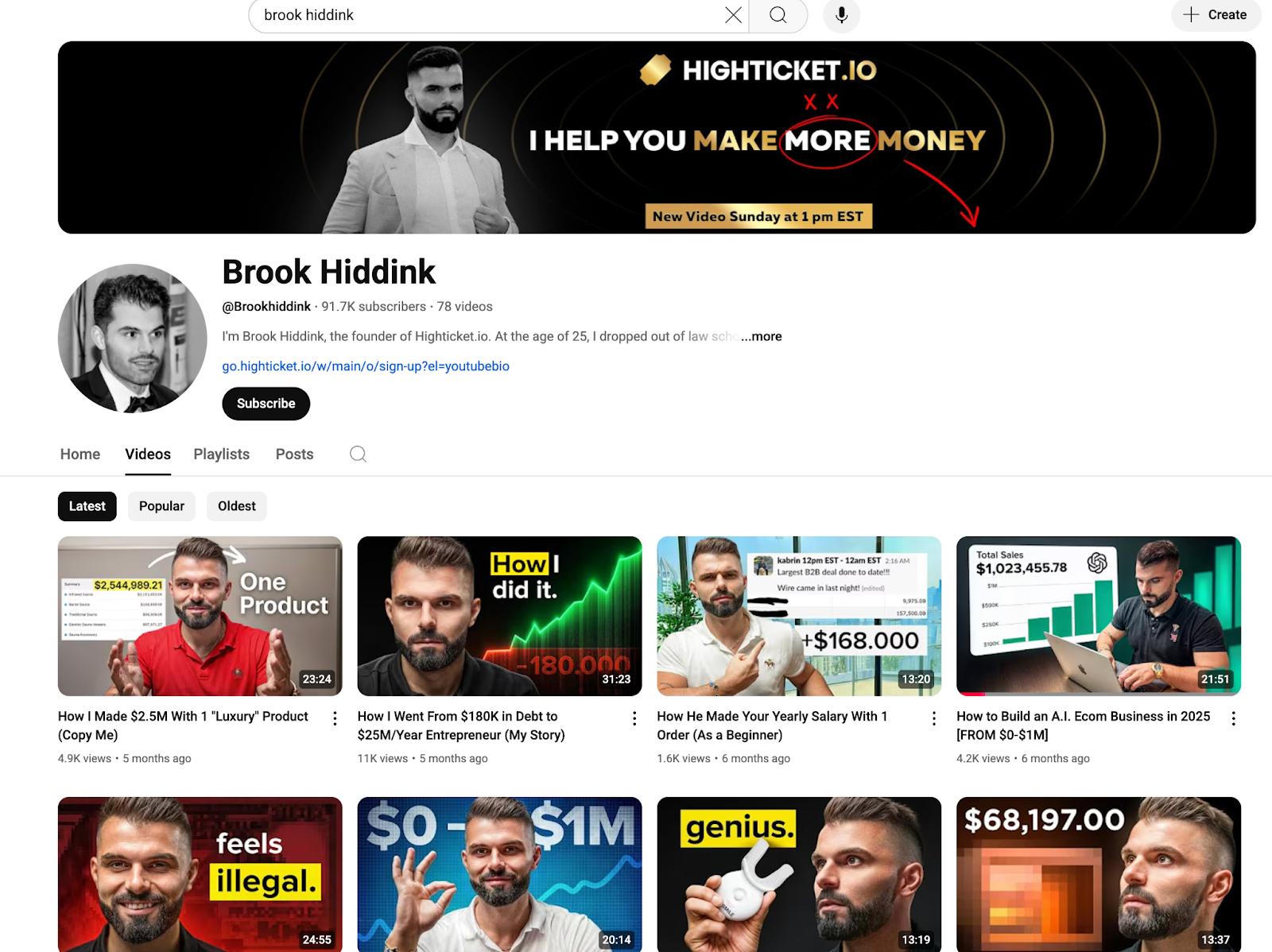
Types of TOFU Content to create:
- Blog Content: SEO-optimized articles that answer questions your ideal customers are searching for. For my e-commerce audience, this means posts like "How to Find Profitable High-Ticket Products" or "Why Most Dropshippers Fail (And How to Avoid It)." I have a dedicated website for this, and it contains several blogs to help you get started as an online dropshipper:

- Short-form videos on TikTok, Instagram Reels, and YouTube Shorts that address common pain points. Behind-the-scenes content performs exceptionally well.
- Platform-specific content that showcases your expertise. LinkedIn posts about business strategy, Twitter threads breaking down successful campaigns, and Instagram carousels with actionable tips.
Social media platforms deserve special attention in your content distribution strategy, as they serve dual purposes: attracting top-of-funnel awareness while simultaneously building the trust necessary for middle-funnel nurturing. Our comprehensive guide to social media marketing for entrepreneurs provides platform-specific strategies, content calendars, and engagement tactics that turn social presence into predictable lead generation for online businesses.
PS: Catch me up on X:
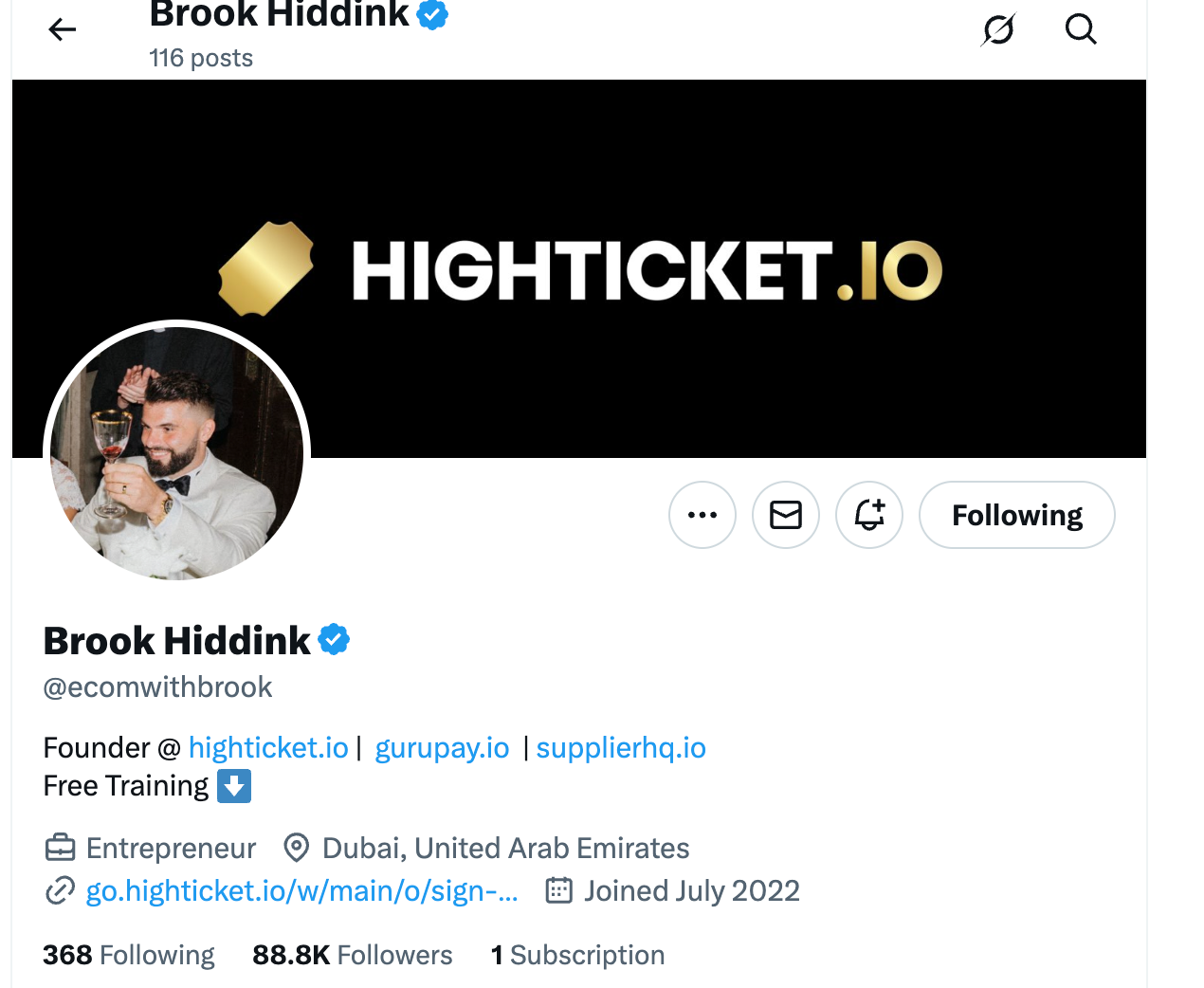
The key is to provide genuine value without asking for anything in return. Some of my highest-performing TOFU content includes:
- How I made $2.5M with 1 luxury product
- How to build an A.I Ecom business in 2025 [from $0 - $1M]
- $1 vs $168,000 products: which one should you sell?
One piece of TOFU content that generated massive awareness was a free dropshipping course: [embed the YouTube video here]
Here, I distilled everything you need to know about high ticket dropshipping, including how to set up your business, find high ticket products to sell, and suppliers, etc.
This course gathered a lot of engagement, and even positive reviews like this:
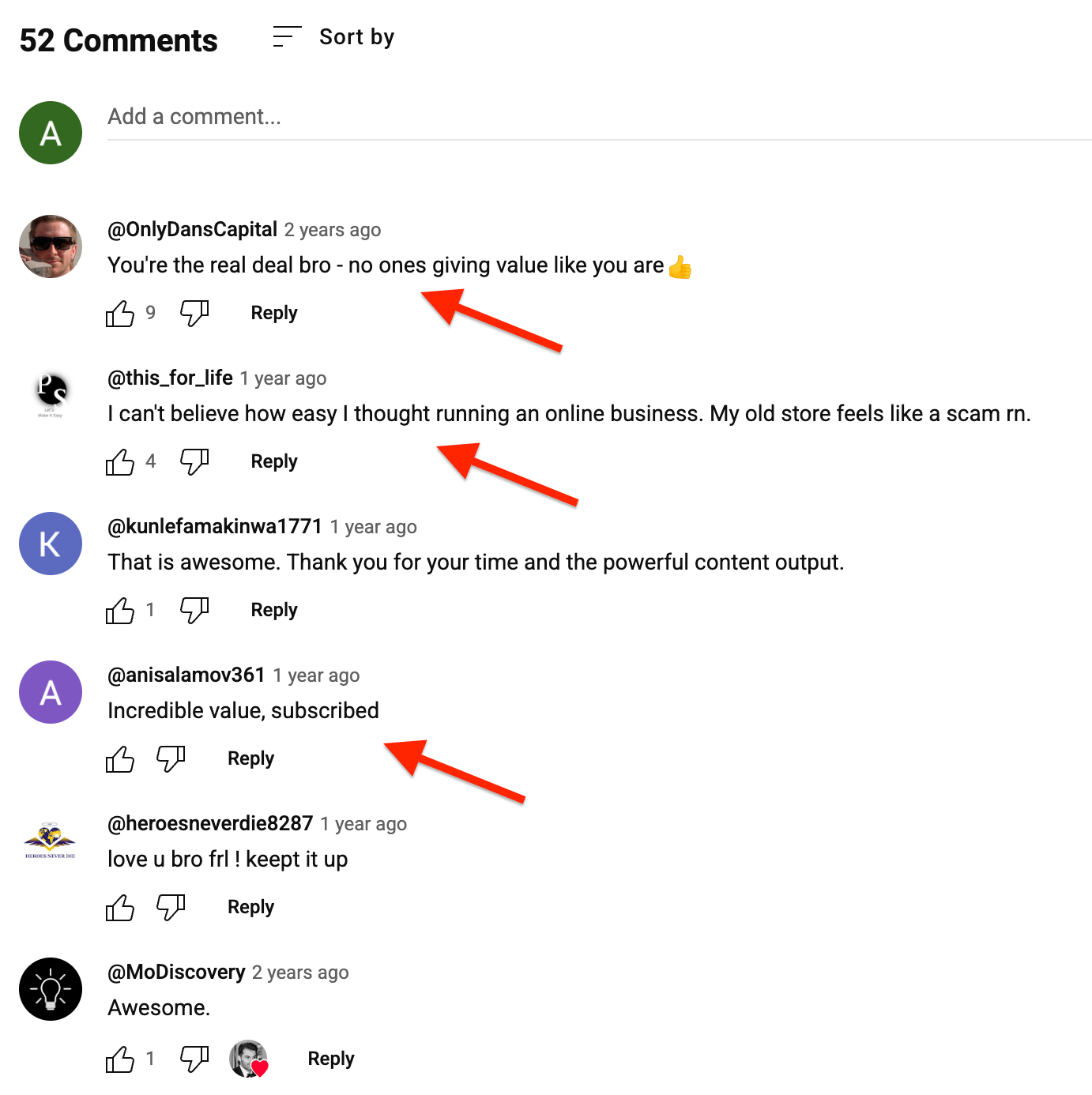
The mistake most businesses make is trying to be clever or mysterious at the top of their funnel. Don't. Be direct, helpful, and specific. Answer the exact questions your prospects are asking.
2. Middle of the Funnel (MOFU) – Consideration
The goal in this stage is to build trust with people who are now aware of their problem and considering solutions.
Middle-of-funnel prospects know they have a problem and are actively researching solutions. They're comparison shopping—not just between products, but between approaches, experts, and philosophies. This is where trust gets built or broken.
At this stage, your content needs to position you as the obvious choice while addressing the specific concerns and objections prospects have about your category of solution.
Types of MOFU Content:
- Email marketing campaigns that deliver value while subtly building your case. My most effective email series guides new subscribers through the exact process of launching a profitable, high-ticket store, sharing real-world examples and lessons learned.
- Detailed breakdowns of customer successes that prove your approach works. But here's the key: show the process, the challenges faced, and how you helped overcome them. People buy confidence, not just outcomes.
For example, I have a dedicated web page where I share some of my students' successes. In each video, they talk about how they achieved it and the products they:
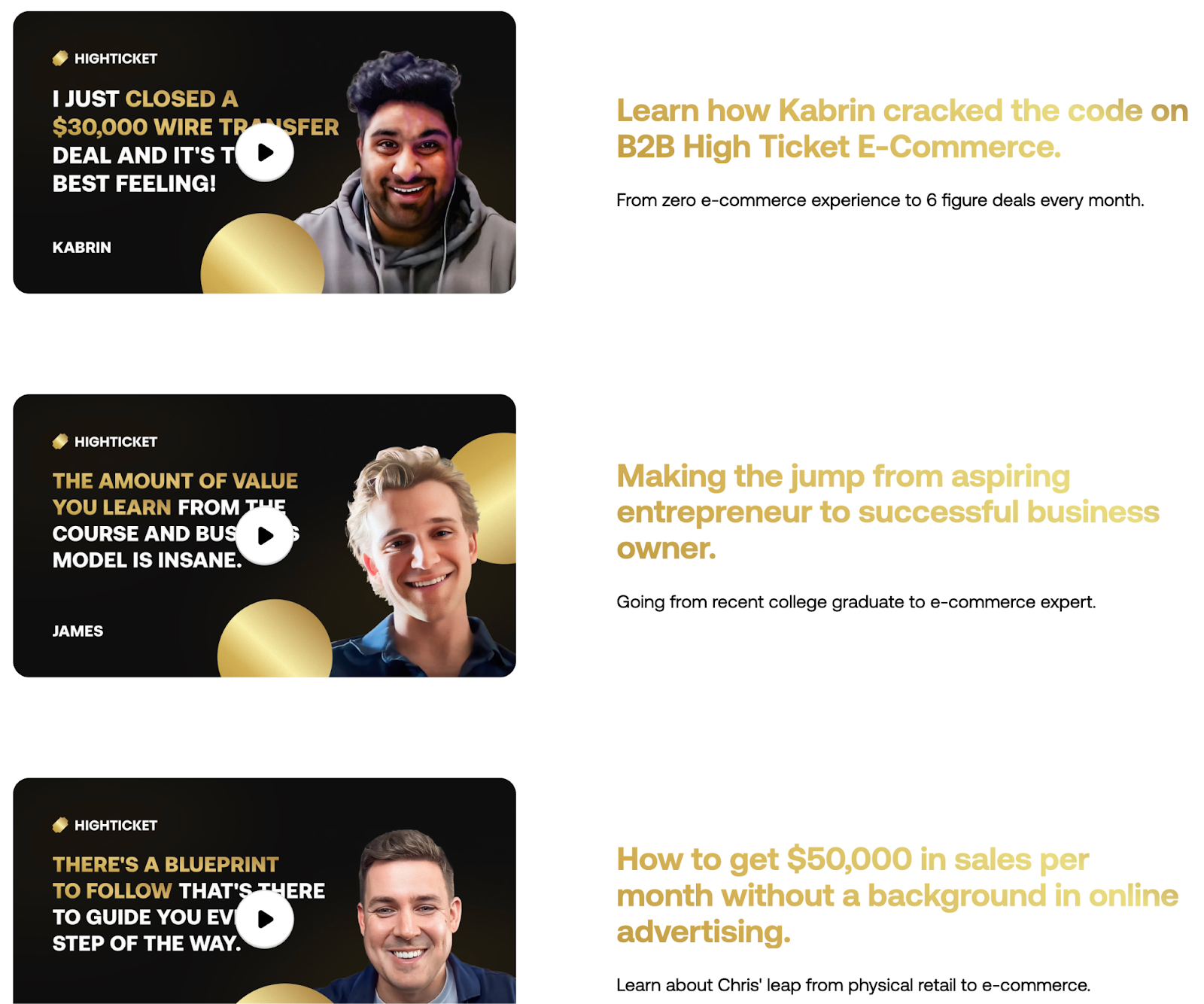
- Live or evergreen presentations that dive deep into your methodology. Webinars work exceptionally well for high-ticket offers because they allow prospects to experience your teaching style and expertise before committing to anything.
MOFU content should feel like consulting, not marketing. You're helping prospects make the right decision for their situation, even if that decision isn't you.
3. Bottom of the Funnel (BOFU) – Decision
The goal of BOFU content is to convert qualified prospects who are ready to buy into customers.
Bottom-of-funnel prospects have done their research, understand their options, and are ready to make a decision. They're asking, "Should I solve it with you?"
Your BOFU content needs to address final objections and make the buying decision feel obvious and low-risk.
Types of BOFU Content:
- Free Trial Offers. Let prospects experience your solution before fully committing. For service-based businesses, this might be a mini-consultation or strategy session. For product businesses, it could be a sample or limited access.
For example, my Supplier and Product Research Tool, SupplierHQ, allows first-time users to use the platform free for 14 days:
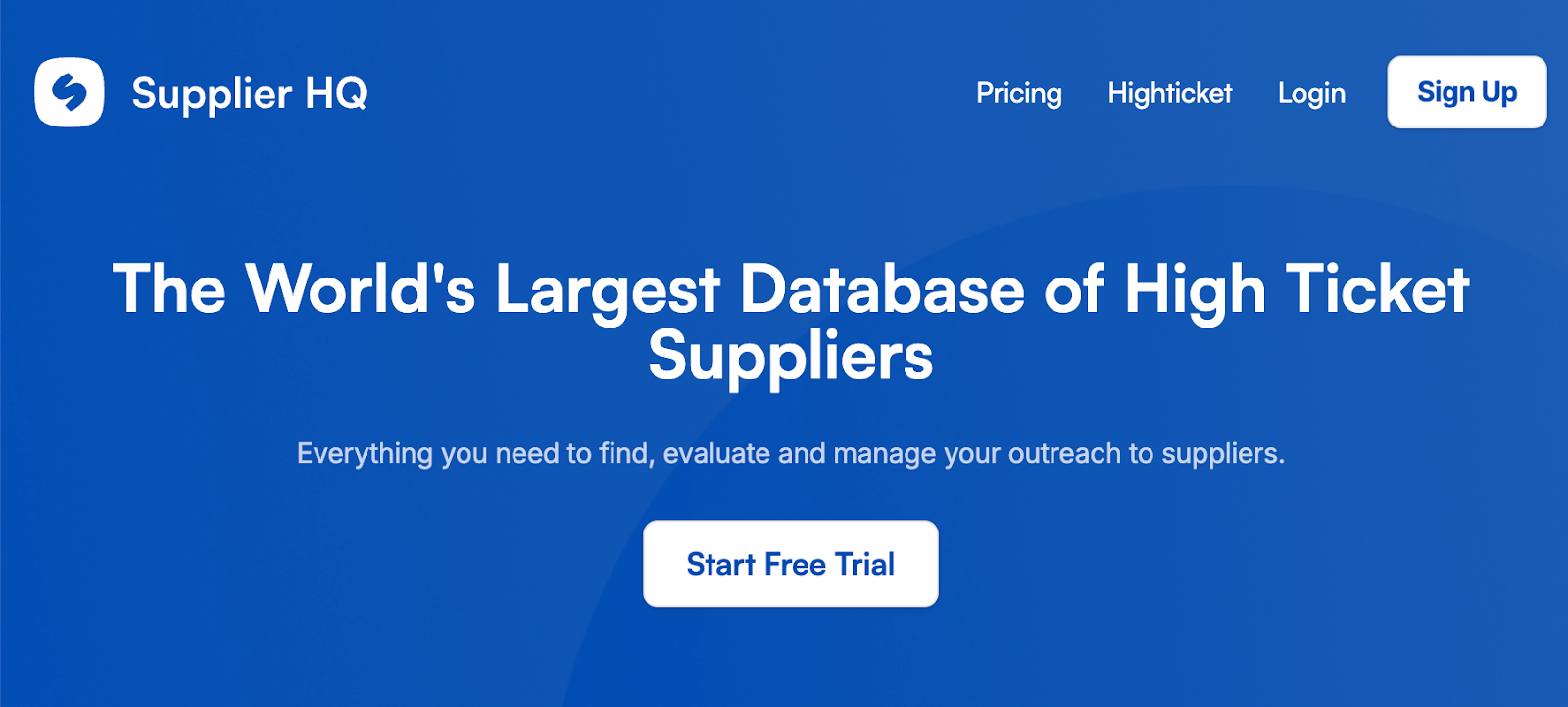
- Product Demos. Show your solution in action. For my high-ticket e-commerce program, I conduct screen shares that show actual student stores, walk through their product research, and demonstrate the tools we use.
- Social proof from real customers addressing specific concerns. The most powerful testimonials don't just say "This works." They say, "This works for someone exactly like you, facing the exact challenges you're facing."
BOFU content should remove friction, not add it. Every piece should make the next step clearer and easier to take. Make your offer feel like the natural next step in a journey you've been guiding them through, not a random sales pitch.
How to Create an Effective Content Marketing Funnel
1. Identify Target Audience and Buyer Journey
You can't build an effective funnel without knowing who you're building it for and how they currently make buying decisions.
Most businesses make their buyer personas way too broad. "Entrepreneurs aged 25-45 interested in online business." That's a census category.
Here's how I approach it: I create ultra-specific buyer personas based on actual customers. For my high-ticket e-commerce program, my core persona is:
“Sarah is a 34-year-old marketing director making $85K annually. She's been following e-commerce content for two years but hasn't started because she's overwhelmed by conflicting advice. She has $ 10,000-$ 15,000 to invest but is terrified of losing it on another failed side hustle. She wants to replace her corporate salary within 12 months but doesn't want to risk her current stability.”
See the difference? Now I can create content that speaks directly to Sarah's specific fears, goals, and situation.
Next, map out their actual buyer journey, not what you think it should be, but what it actually is. Interview existing customers about their process:
- How did they first discover you?
- What content did they consume before reaching out?
- What objections did they have at each stage?
- What finally convinced them to buy?
- How long was their decision-making process?
This research reveals the exact content gaps you need to fill.
2. Align Marketing Strategies with Funnel Stages
Each stage of your funnel requires different marketing strategies and content formats.
- TOFU Strategy: Cast a wide net with educational content optimized for search and social discovery. Focus on SEO-driven blog posts, short-form video content, and social media posts that showcase expertise without being salesy.
- MOFU Strategy: Nurture with email sequences, longer-form content like webinars or case studies, and retargeting campaigns for people who've engaged with your TOFU content. This is where you build deeper relationships.
- BOFU Strategy: Direct-response tactics like sales pages, product demos, and consultation bookings. Use scarcity and urgency appropriately—but only when it's genuine.
The biggest mistake I see: businesses using BOFU tactics (like sales pages and demos) at the TOFU stage. Someone who just discovered you isn't ready for your product demo. They need education first.
3. Ensure Your Content is Designed for Each Stage
Every piece of content should have a clear objective and be optimized for its funnel stage. Here’s how:
TOFU Content Guidelines:
- Answers questions prospects are already asking
- Provides value without requiring any commitment
- Positions you as credible and worth following
- Includes subtle calls-to-action to move to MOFU (like email signup)
MOFU Content Guidelines:
- Builds on TOFU concepts but goes deeper
- Addresses specific objections about your solution category
- Demonstrates your unique approach or methodology
- Includes stronger calls-to-action (webinar signup, consultation booking)
BOFU Content Guidelines:
- Assumes they understand the problem and want a solution
- Focuses on why you/your solution vs. alternatives
- Addresses final objections about you specifically
- Includes clear purchase or commitment calls to action
4. Maintain Consistency in Messaging
Your funnel should feel like a cohesive journey, not random content pieces. Prospects should feel like they're going deeper into the same conversation, not jumping between different topics and tones.
I maintain consistency through:
- Core Message Pillars. Everything I create ties back to three main themes: high-ticket e-commerce works better than low-ticket, education beats hype, and results come from implementation, not information.
- Consistent Voice. Whether someone reads my blog, watches my videos, or receives my emails, they should recognize my conversational, direct style, which balances expertise with relatability.
- Progressive Value. Each stage builds on the previous one. My blog posts introduce concepts that my emails expand on and my webinars demonstrate in action.
- Visual Identity. Consistent colors, fonts, and design elements across all content make the experience feel professional and intentional.
4. Repurpose Content for Multiple Marketing Channels
Creating entirely new content for every platform is unsustainable and unnecessary. The key is strategic repurposing that adapts core messages for different channels and audiences.
Here's my content multiplication strategy:
Start with one comprehensive piece (like a detailed blog post or case study), then adapt it for:
- Twitter threads highlighting key points
- Instagram carousel posts with visual summaries
- LinkedIn articles with a more professional angle
- YouTube videos walking through the concepts
- Email newsletter segments delivered over time
- Podcast talking points for interviews
One case study about a student's success becomes 10+ pieces of content across different channels. For example, I have student videos on my website:
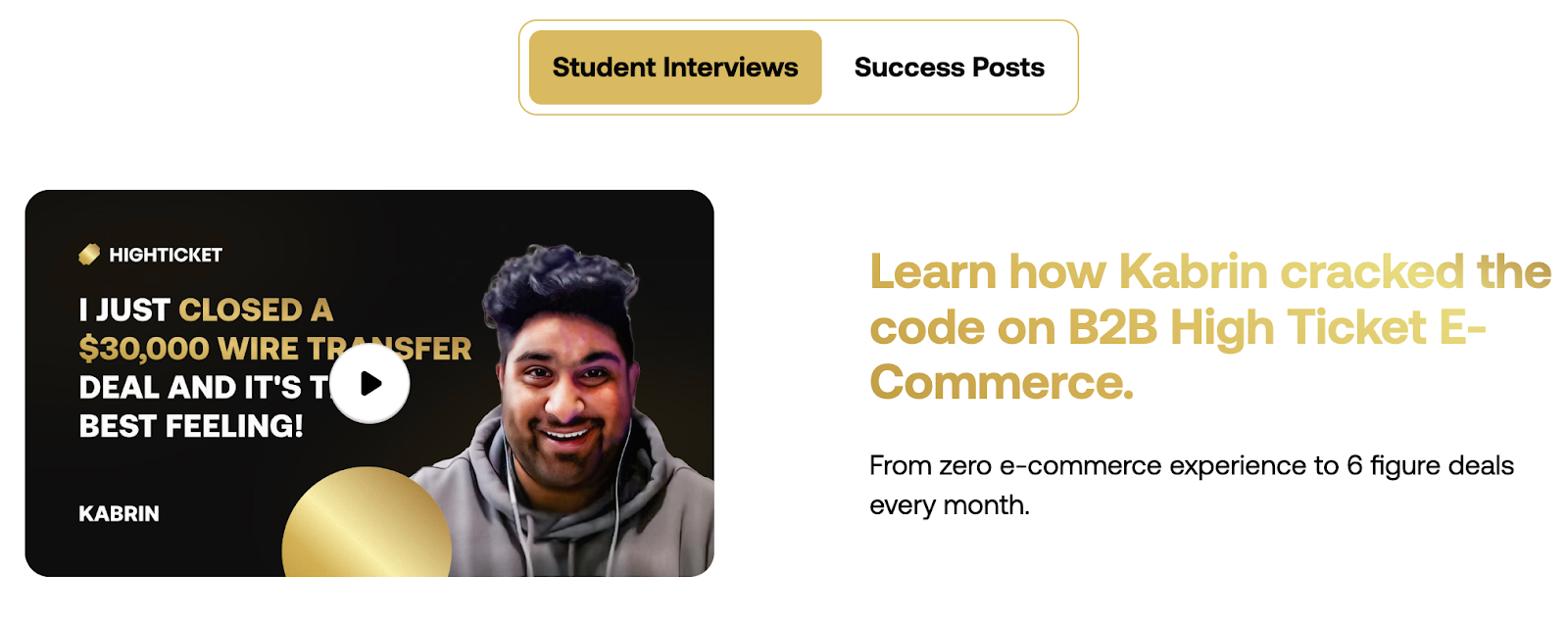
And a YouTube channel as well:

But don't just copy and paste. Adapt the format, tone, and focus for each platform while maintaining the core message. A LinkedIn post about a student success story might focus on business lessons learned, while the Instagram version might highlight the lifestyle transformation.
How to Optimize and Measure Funnel Effectiveness
1. Track the Right Metrics at Each Stage
Likes, shares, and even website traffic don't matter if they're not converting to business results. Here are the metrics that actually matter at each funnel stage:
TOFU Metrics:
- Qualified traffic (visitors who fit your ideal customer profile)
- Email subscription rate from content
- Social media follower growth (in your target demographic)
- Content engagement from ideal prospects
- Branded search volume increases
MOFU Metrics:
- Email open and click rates
- Content consumption depth (time on page, video completion rates)
- Lead magnet conversion rates
- Webinar attendance and completion rates
- Retargeting audience growth
BOFU Metrics:
- Sales qualified leads generated
- Consultation booking rates
- Proposal-to-close ratios
- Customer acquisition cost
- Average deal size and lifetime value
The key is connecting these metrics to revenue impact. I track not just how many people subscribe to my email list, but what percentage of subscribers eventually become customers and what their average purchase value is.
2. Implement Conversion Rate Optimization
Small improvements at each funnel stage compound dramatically. A 10% improvement in TOFU conversion rates, combined with 10% improvements in MOFU and BOFU, results in 33% more customers overall.
- TOFU Optimization: Test different headlines, content formats, and calls-to-action on your most popular content. I've seen single headline changes increase email signups by 40%+.
- MOFU Optimization: Test email subject lines, send times, and content sequences.
- BOFU Optimization: Test sales page headlines, social proof placement, and offer positioning.
The key is to test one variable at a time and give the tests enough time to reach statistical significance.
3. Use Data to Identify Content Gaps
Your analytics reveal exactly where prospects are dropping off and what content you're missing.
- High bounce rate on specific blog posts? The content doesn't match what prospects expected from the headline, or it's not providing enough value.
- Low email click rates on specific topics? Your audience isn't interested in that content, or you need to improve how you're presenting it.
- High webinar registration but low attendance? There's a mismatch between what you promised and what people think they're getting.
- Lots of consultation bookings but low closing rates? This means your MOFU content isn't qualifying prospects properly, so unqualified leads are making it to sales calls.
I do quarterly content audits to identify the biggest drop-off points and create specific content to address those gaps.
3. Personalize Content Based on Behavior
Not all prospects are the same, so your content shouldn't treat them the same way. Use behavior-based segmentation to deliver more relevant content:
- Segment email subscribers based on which lead magnets they downloaded
- Show different blog content recommendations based on previous reading history
- Create separate nurture sequences for different audience segments
- Use retargeting to show stage-appropriate ads
For example, someone who downloads my "Supplier Database" gets different email content than someone who downloads my "Niche Research Guide." The first person is further along in the process and ready for more advanced content.
4. Continuously Test and Iterate
The most successful content marketing funnels are never "finished." They're constantly being tested, refined, and improved based on data and feedback.
To do this, set up a systematic testing schedule:
- Monthly: Test email subject lines and content formats
- Quarterly: Test major funnel components like lead magnets and sales pages
- Annually: Review and refresh your entire content strategy
Keep a testing log that tracks what you tested, the results, and the insights gained. This prevents you from retesting the same things and helps you identify patterns in what works for your audience.
Conclusion
An effective content marketing funnel guides prospects naturally from strangers to customers.
Here's what I've learned after helping students generate millions through strategic content funnels: Success comes from consistency, not perfection. Start with one piece of valuable content that serves your ideal customer at their current stage. Test it, optimize it, and build from there.
Final tip: Align your content strategy with every stage of the funnel to maximize ROI. Don't try to build the entire funnel overnight. Pick one stage, create exceptional content for that stage, and gradually expand. The businesses that scale fastest are the ones that build systematically, not sporadically.
While the traditional top-down funnel model works exceptionally well for most online businesses, some entrepreneurs are experimenting with alternative approaches that flip the conventional wisdom on its head. Our guide to reverse funnel marketing explores how starting with your highest-intent prospects and working backward can accelerate results for specific business models, particularly those with established audiences or strong referral networks.
Your prospects are out there right now, looking for solutions to their problems. A well-built content marketing funnel ensures they find you, trust you, and choose you when they're ready to buy.
FAQs
What is the difference between a marketing funnel and a content marketing funnel?
A marketing funnel is the overall framework showing how prospects move from awareness to purchase—it's the roadmap. A content marketing funnel specifically uses valuable content as the primary vehicle to move prospects through each stage.
Think of it this way: A marketing funnel might include paid ads, sales calls, and email campaigns. A content marketing funnel achieves the same goal primarily through educational blog posts, videos, case studies, and other valuable content that builds trust over time.
Content marketing funnels are more effective for complex, high-ticket, or trust-dependent purchases, where prospects require education and relationship-building before they're ready to make a purchase.
What type of content works best at each funnel stage?
Top of Funnel: Educational content that addresses problems your prospects face. Blog posts that answer common questions, how-to videos, industry trend analyses, and social media tips work well. The key is to provide value without expecting anything in return.
Middle of Funnel: Content that demonstrates your unique approach and builds trust. Case studies, webinars, detailed email courses, comparison guides, and behind-the-scenes content are most effective. You're proving you can solve their problem.
Bottom of Funnel: Content that addresses final objections and makes buying decisions easier. Product demos, customer testimonials, FAQ content, pricing comparisons, and risk-reversal offers work well. You're removing the final barriers to purchase.
The biggest mistake is using bottom-of-funnel content (like sales pages) when prospects are still at the top of the funnel and need education first.
How do I know if my content marketing funnel is effective?
Look at progression metrics, not just vanity metrics. Track how many people move from one stage to the next:
- What percentage of website visitors become email subscribers?
- What percentage of subscribers attend your webinars or consume your middle-funnel content?
- What percentage of engaged leads become customers?
Also, monitor key business metrics, such as customer acquisition cost, lifetime value, and overall revenue growth. An effective content marketing funnel should steadily improve these numbers over time.
If you're experiencing high traffic but low conversions, your content may not be addressing the right problems, or your calls-to-action might be ineffective. If you're getting qualified leads but they're not buying, your bottom-funnel content needs work.
What are common mistakes businesses make in funnel content?
The biggest mistake is creating content for the wrong stage of the funnel and trying to sell too early (using sales content when prospects need education) or educating when prospects are ready to buy.
Other common mistakes include:
- Making buyer personas too broad instead of ultra-specific
- Creating content without clear objectives or calls-to-action
- Inconsistent messaging across different content pieces
- Not testing and optimizing based on actual data
- Focusing on vanity metrics instead of conversion metrics
- Creating content without understanding the actual buyer journey
Most businesses also give up too early. Content marketing funnels take time to build momentum. The compound effect doesn't kick in until you've been consistently creating and optimizing for several months.
Can a content marketing funnel work for both B2B and B2C businesses?
Absolutely, but the approach and timeline are different.
B2C content marketing funnels work faster with more emotional, lifestyle-focused content. The buying decisions are often individual and based on personal desires or immediate needs.
B2B content marketing funnels require longer nurture periods with more educational, ROI-focused content. You're often selling to committees and need to address the concerns of multiple stakeholders.
The core principle—using valuable content to build trust and guide prospects through a buying journey—works for both. But B2B funnels typically need more case studies, ROI calculators, and industry-specific content, while B2C funnels might focus more on aspirational content and social proof.
The key is to understand your specific audience's buying process and create content that matches their needs at each stage, regardless of whether you're targeting a B2B or B2C audience.

